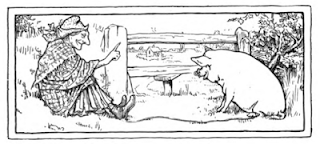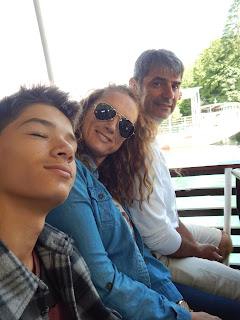Reading Notes- English Fairy Tales- Part A&B
Part A-
What a RIDE this reading was. I found it so amusing and
precious at the same time. This is the first reading that I have read for this
class that has followed a rhyme scheme. Half-way through the reading, I found
myself humming the tune and singing the words to the story, which made reading
it all that more fun. Despite all being together in one reading, each of the
stories are so different from each other. I particularly got caught on The Woman and Her Pig, which at first extremely annoyed me as I was trying to read
it in my head. But then I re-read it out-loud and it was actually such a fun
play on words. The story builds and build until it hits the climax, then like
an upside triangle, it works it’s way down.
Building up: “She
went a little further, and she met a cat. So she said: 'Cat! cat! kill rat; rat
won' t gnaw rope; rope won't hang butcher; butcher won't kill ox; ox won't
drink water; water won't quench fire; fire won't burn stick; stick won't beat
dog; dog won't bite pig; piggy won't get over the stile; and I shan't get home
tonight.”
Breaking down: “the
cat began to kill the rat; the rat began to gnaw the rope; the rope began to
hang the butcher; the butcher began to kill the ox; the ox began to drink the
water; the water began to quench the fire; the fire began to burn the stick;
the stick began to beat the dog; the dog began to bite the pig; the little pig
in a fright jumped over the stile; and so the old woman got home that night.”
How funny is that!!
I mean it is a mouthful but really I thought it was so interesting.
Bibliography: Joseph Jacobs, English Fairy Tales, Link
Part B-
The funniest part about these stories in my opinion are how
the plot will just be going along all nice and sweetly, and then in the last
two sentences everything will go downhill, and sometimes it will just end with
“and then he/she died.” I probably shouldn’t giggle, but it is such an abrupt
way to end a story that I never know how to react other than that it is funny! I
really liked the second part of this reading because it reminded me of Anansi
stories. The main characters are quite the tricksters, and they do whatever it
takes to get what they want. There is quite a bit more violence in these
stories then original fables. For example, in the story of Molly Whuppie,
this clever little girl deceives a Giant not once, but four times, including the
killing of practically the Giant’s entire family:
‘The giant's wife begged that Molly would take her up into the sack till
she would see what Molly saw. So Molly took the shears and cut a hole in the
sack, and took out the needle and thread with her, and jumped down and helped
the giant's wife up into the sack, and sewed up the hole.’
‘The giant's wife saw nothing, and began to
ask to get down again; but Molly never minded, but hid herself at the back of
the door. Home came the giant, and a great big tree in his hand, and he took
down the sack, and began to batter it. His wife cried, 'It's me, man'; but the
dog barked and the cat mewed, and he did not know his wife's voice’
Bibliography: Joseph Jacobs, English Fairy Tales, Link




Comments
Post a Comment